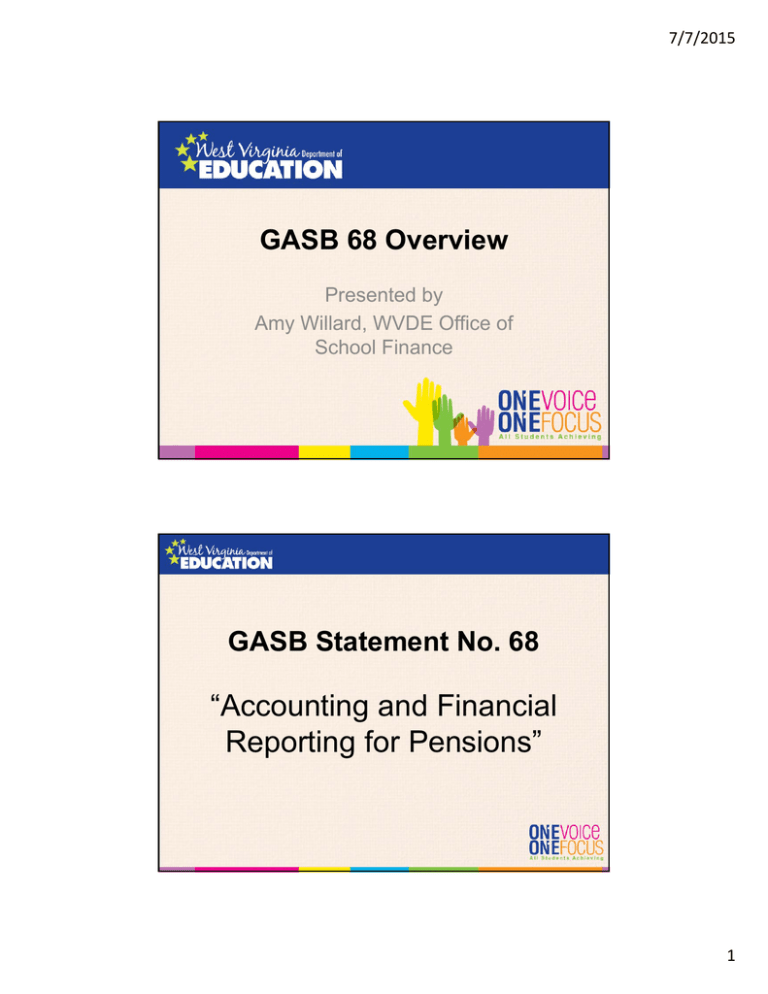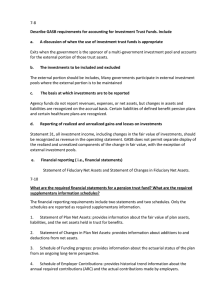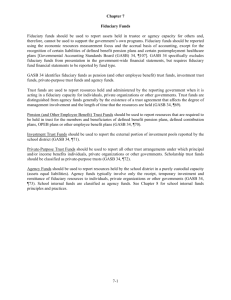“Accounting and Financial Reporting for Pensions” GASB 68 Overview GASB Statement No. 68
advertisement

7/7/2015 GASB 68 Overview Presented by Amy Willard, WVDE Office of School Finance GASB Statement No. 68 “Accounting and Financial Reporting for Pensions” 1 7/7/2015 • Objective - To improve accounting and financial reporting by state and local governments for pensions. • Applicability - Applies to all state and local government employers whose employees are provided with pensions through pension plans that are administered through trusts and to nonemployer contributing entities that have a legal obligation to make contributions directly to such pension plans. • Effective - For fiscal years beginning after June 15, 2014. We must implement GASB 68 for the FY15 financial statements. GASB 68 replaces GASB 27 (Accounting for Pensions by State and Local Government Employers) and GASB 50 (Pension Disclosures) as they relate to pensions that are provided through trusts that meet certain criteria. • For pensions that aren’t covered by the scope of GASB 68, GASB 27 and GASB 50 would still apply. • GASB 68 does apply to our pension plans administered by the WV Consolidated Public Retirement Board (CPRB). 2 7/7/2015 Categories of Employers GASB 68 classifies employers into one of the following categories: – Single employers – Agent employers – Cost-sharing employers County School Boards in West Virginia are considered cost-sharing employers . What are cost sharing employers? Cost Sharing Employers are those whose employees are provided with defined benefit pensions through cost-sharing multipleemployer pension plans (pension plans in which the pension obligations to the employees of more than one employer are pooled and plan assets can be used to pay the benefits of the employees of any employer that provides pensions through the pension plan). 3 7/7/2015 Special Funding Situations • Special Funding Situations are circumstances in which a nonemployer entity is legally responsible for making contributions directly to a pension plan that is used to provide pensions to the employees of another entity or entities and either of the following conditions exist: 1) The amount of contributions for which the nonemployer entity is legally responsible is not dependent upon one or more events or circumstances unrelated to the pensions. 2) The nonemployer entity is the only entity with a legal obligation to make contributions directly to a pension plan. Special Funding Situations Examples of conditions that meet the first criterion: 1. A circumstance in which the nonemployer entity is required by statue to contribute a defined percentage of an employer’s covered employee payroll directly to the pension plan. 2. A circumstance in which the nonemployer entity is required by the terms of a pension plan to contribute directly to the pension plan a statutorily defined proportion of the employer’s required contributions to the pension plan. 4 7/7/2015 Special Funding Situations Special funding situations do not include circumstances in which the resources are provided to the employer, regardless of the purpose for which those resources are provided. TRS Special Funding Situation • CPRB has determined that the TRS system does have a special funding situation in accordance with GASB 68’s definition. • This is based on the requirements of the Public School Support Program (PSSP) of WVC 18-9A-6(b) and 189A-6(c) in which the current retirement contributions for employees are sent directly to CPRB in lieu of payments from the county boards of education and in which the Legislature is required to make payments to eliminate the unfunded TRS pension liability over a 40 year period beginning in 1994. 5 7/7/2015 Terminology Changes Old • Actuarial Accrued Liability (AAL) • Unfunded Actuarial Accrued Liability (UAAL) New • Total Pension Liability (TPL) • Net Pension Liability (NPL) Actuarial Valuations • The statement requires actuarial valuations of the TPL to be performed at least every two years, with more frequent valuations encouraged. The TPL will either be as of a particular measurement date or will be a rolled forward amount of a measurement date no more than 30 months and 1 day earlier than the employer’s most recent fiscal year end. • All assumptions underlying the determination of the TPL and related measures set forth by the statement are required to be made in conformity with Actuarial Standards of Practice issued by the Actuarial Standards Board. 6 7/7/2015 Total Pension Liability (TPL) What factors determine the TPL? – Discount Rate (LT Rate of Return) – The types of benefits a government has promised – The length of service of employees and their salaries in the final years of their employment – The life expectancy of retirees, which determines how long they will continue to receive benefits – The inflation rate, which affects both salaries and the rates of return on investments Net Pension Liability TPL – Fair Value of Plan Assets = NPL NPL should be measured as of a date (the measurement date) that is no earlier than the end of the employer’s prior fiscal year. 7 7/7/2015 Changes in NPL Fund-Level Financial Statements • In governmental fund financial statements, the cost sharing employer’s proportionate share of the collective net pension liability is required to be recognized to the extent the liability is normally expected to be liquidated with expendable available financial resources. • Pension expenditures should be recognized equal to the total of (1) amounts paid by the employer to the pension plan and (2) the change between the beginning and ending balances of amounts normally expected to be liquidated with expendable available financial resources. • Essentially, there are no changes to the fund level financial statements. 8 7/7/2015 District-Wide Financial Statements County Boards of Education will record their proportionate share (adjusted for the special funding situation) for the following for TRS as determined by CPRB through their audited allocation schedules: • NPL • Deferred outflows/inflows • Pension Expense Footnote Disclosures The footnotes must disclose the following information (list is not comprehensive): • Descriptive information about the pension plans through which the pensions are provided. • Discount rate and assumptions made in the measurement of the employer’s proportionate share of NPL. • Information about how the contributions to the pension plan are determined. 9 7/7/2015 Footnote Disclosures • Due to the special funding situation, the footnotes will also have to include not only the county board’s proportionate share of the NPL, but also the State’s proportionate share of NPL associated with that county board. • We will be unable to get that amount directly from the CPRB audited allocation schedules. However, CPRB’s auditors have developed a draft calculation that county boards will be able to utilize to calculate the amount for the footnotes. Almost all numbers utilized in the calculation come from the CPRB audited allocation schedules, but one number will come from WVDE’s annual retirement allocation schedule. This calculation will be shared once the CPRB allocation schedules have been finalized and comprehensive guidance can be shared. RSI – Schedule of Proportionate Share of the Net Pension Liability • GASB 68 requires cost-sharing employers to present in required supplementary 10 year schedules containing: (1) (2) (3) (4) (5) (6) (7) • • Employer’s proportionate share of NPL as a % Employer’s proportionate share of NPL in $ State’s proportionate share of NPL associated with the Employer in $ Subtotal of (2) and (3) Employer’s covered employee payroll Proportionate share of NPL as a % of covered payroll Plan net position as a % of TPL The information gradually builds up to 10 years and then is presented for a rolling 10-year period. For FY15 financials, only one year will be presented. This schedule is as of the measurement date for TRS, not the fiscal year end of the county board. 10 7/7/2015 RSI – Schedule of Contributions • GASB 68 requires cost-sharing employers to present in required supplementary 10 year schedules containing: 1. 2. 3. 4. • • Contractually required contribution Contribution in relation to the contractually required contribution Covered employee payroll Contributions as a percentage of covered-employee payroll The information gradually builds up to 10 years and then is presented for a rolling 10-year period. For FY15 financials, only one year will be presented. This schedule is as of the fiscal year end date for the county board of education. GASB Statement No. 71 “Pension Transition for Contributions Made Subsequent to the Measurement Date – An Amendment of GASB Statement No. 68” Effective Date: Simultaneous with GASB 68 11 7/7/2015 GASB 71 Under GASB 68, if it is not practical for an employer or non-employer contributing entity to determine the amounts of all deferred outflows of resources and deferred inflows of resources related to pensions, paragraph 137 requires that beginning balances for deferred outflows and deferred inflows not be reported. GASB 71 Consequently, if it is not practical to determine the amounts of all deferred outflows and inflows, contributions made after the measurement date of the beginning NPL could not have been reported as deferred outflows of resources at transition. This could have resulted in a significant understatement of an employer’s beginning net position and expense in the initial period of implementation. 12 7/7/2015 GASB 71 GASB 71 amends paragraph 137 of GASB 68 to require that, at transition, a government recognize a beginning deferred outflow of resources for its pension contributions, if any, made subsequent to the measurement date of the beginning net pension liability. The beginning balances for other deferred outflows and inflows of resources related to pensions should only be reported at transition if it is practical to determine all such amounts. GASB 71 What does this mean for county boards of education? Because the measurement date used by CPRB for TRS is June 30, 2014, we will have additional year-end entries on the district-wide statements to take our current year pension payments out of expense and put them into deferred outflows of resources. Sample entries will be provided as part of comprehensive GASB 68 implementation guidance released once we receive the audited allocation schedules from CPRB. 13 7/7/2015 Questions? 14





